| Ann. Aledit. Burns Club - voL VII - n. 3 - September 1994
A MULTIMEDIA COMPUTERIZED TEACHING SYSTEM
IN THE FIELD OF BURNS THE COMETT PROJECT OF THE EUROPEAN UNION
M. Masellis*, M. Costagliola**, V.
Garcia Torres***, J. loannovich****, G. Magliacani*****
* Divisione di Chirurgia
Plastica. 9 Terapia delle Ustioni, Palermo, Italy
** Service de Chirurgie Plastique et Est6tique, Rangueil, Toulouse, France
*** Unidad de Cirugia Plastica y Quemaduras, Madrid, Spain
**** Centre of Plastic Surgery and Microsurgery, Athens, Greece
***** Divisione di Chirurgia Plastica e Centro Grandi Ustionati, Turin, Italy
SUMMARY. COMETT
(Community Programme for Education and Training in Technology) is an instrument proposed
by the European Union to improve cooperation between universities, research institutes
ang1the world of business. One of COMETT's objectives is to use this cooperation to
accelerate the process of technological transfer from higher education institutions to
industrial applications by promoting training courses using new technologies. In the
spirit of the COME`IT project, in 1990 the Mediterranean Bums Club presented a proposal
entitled "European network for the establishment of textual and iconographic
documentation relative to bums in the Mediterranean area", with the objective of
producing a training plan common to all the partners by the use of innovative technologies
and in particular interactive multimedia applications. The main purposes of the project
are to improve and make more uniform the level of professional specialization, to promote
activities in the field of prevention, therapy and rehabilitation of the bum patient, and
to improve care and rescue work in fire disasters. Five academic partners and one
technical partner were involved in the preparation of the project. The system is a genuine
teaching instrument that can be used both for training in the general field of bums and
for in-depth study of specific issues. The technological solutions adopted in the project
are described. The results obtained by the project can be summarized as follows: training
of all the academic partners in the potentials of image processing systems; training in
systems and methodologies for developing multimedia applications; production of a
multimedia application on CD-ROM for use as a training instrument in Bums Centres for
medical and paramedical personnel and as a teaching aid in university medical degree
courses with particular reference to bums.
Introduction
The European Community, now called the
European Union (EU), has replaced the Common Market and now constitutes the world's second
most important intergovernmental union, after the United Nations. It is a major
international educational institution.
COMETT is the acronym for Community
Programme for Education and Training in Technology. Launched in 1986 and renewed in
1990, it is one of the instruments proposed by the EU to improve cooperation between
universities, research institutes and the world of business. One of COMETT's objectives is
to use this cooperation to accelerate the process of technological transfer from higher
education institutions to industrial applications by promoting training courses using new
technologies.
Taking into account the special needs of small and medium-sized companies, COMETT has
developed a highly efficient network of collaboration between universities, institutions
and companies in EU countries in the field of training.
The Mediterranean Burns Club (MBC) was founded in 1983. An international organization
comprising all the countries in the Mediterranean area, the MBC proposes to unite the
capacities of all burn specialists in order to aria lyse common issues, analogies and
contrasts in prevention of fire disasters and the treatment and functional recovery of bum
victims.
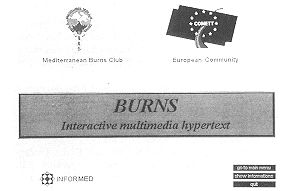 |
Fig. 1 -
"Burns": a multimedia teaching system in the field of burns. |
|
These activities aim at analysing and evaluating the
actual situation in the individual countries in order to promote contacts and comparisons
on clinical, therapeutic, scientific, didactic and care problems, with a view to the
elimination of existing divergences and weaknesses.
Among the various activities of the MBC (prevention, treatment, rehabilitation, response
to emergencies, promotion of exchanges between Member countries, study, research, training
and dissemination), the training of medical personnel in the various countries plays an
important role by ensuring the continuous updating of specialist capacity in the sector.
In the spirit of the COMETT project, in 1990 the MBC presented a proposal entitled
"European network for the establishment of textual and iconographic documentation
relative to burns in the Mediterranean area", with the objective of producing a
training plan common to all the partners by the use of innovative technologies and in
particular interactive multimedia applications. In 1991 the European Union declared the
proposed plan to be particularly interesting for approval, and gave the go-ahead for the
project.
The opportunity was thus taken to rationalize all acquired knowledge by the creation of a
text and image data bank through the collaboration of five European partners, to be used
with appropriate multimedia instruments for the training of medical personnel working in
burns cen~ tres, universities and hospitals.
The main purposes of the project are:
- to improve and make more uniform the level of pro~
fessional specialization;
- to promote activities in the field of prevention, therapy
and rehabilitation of the burn patient;
- to improve care and rescue work in fire disasters.
In the development of the project the MBC
has played the role of the main contractor and scientific coordinator, in collaboration
with the five European academic partners, which are:
- Centre of Plastic Surgery and Microsurgery, Athens, Greece.
Director, Prof. J. 10annovich
- Department of Plastic Surgery and Burns (Unidad de Cirugia
Plastica y Quemaduros), Madrid, Spain. Director, Prof. V. Garcia-Torres
- Department of Plastic Surgery and Burns Therapy (Divisione
di Chirurgia Plastica c Terapia delle Ustioni), Palermo, Italy. Director, Prof. M.
Masellis
- Department of Plastic and Aesthetic Surgery (Service de
Chirurgie Plastique et Esthétique), Rangueil, Toulouse, France. Director, Prof. M.
Costagliola
- Department of Plastic Surgery and Burns Centre (Divisione
di Chirurgia Plastica c Centro Grandi Ustionati), Turin, Italy. Director, Prof. G.
Magliacani
The necessary technical and information
technology know-how for the project. was provided by INFORMED Ltd., a leading company in
the field of information technology and multimedia communication, which was thus the
technological partner in the project.
For the realization of the project a consortium was set up, with a Technical and
Scientific Committee for the coordination of all activities. This Committee comprises two
representatives from MBC, two representatives of the partners and a representative of the
company. The Committee meets regularly at the seat of the MBC in Palermo. The Scientific
Editor is Prof. S. W. A. Gunn, President of the MBC.
The Technical and Scientific Committee has been responsible for the choice of teaching
topics, training activities at the Centres of the partners, and the correct Progress of
the various phases of the project.
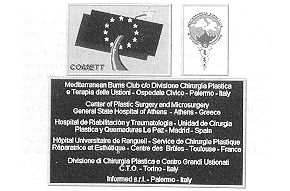 |
Fig. 2 - European
Academic Partners of COME7T Project. |
|
The aim of the project
The aim of the project is to
facilitate communication in the field of knowledge regarding burns and fire disasters in
the Mediterranean countries in order to consolidate all relevant experience and improve
care. This experience will be used to improve the training of medical and paramedical
personnel who specialize in the treatment of burns, in the psychological and functional
recovery of burn patients and in the prevention and management of fire disasters.
To achieve the training aims of the project, an interactive multimedia application was
developed on CD-ROM that can be used by anyone with access to a personal computer.
This application is a genuine teaching instrument that can be used both for training in
the general field of burns and for in-depth study of specific issues. The application's
multimedia interface and its case and immediacy of use make it a particularly flexible
product that can be handled by various categories of users: medical students physicians
specializing in burns paramedical personnel engaged in burn patient care medical,
paramedical and nursing teachers voluntary workers and the general public as regards
prevention, first aid and initial response in fire disasters
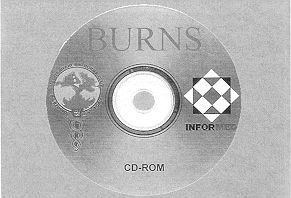 |
Fig. 3 - The aim
of the project: the CD-ROM as teaching instrument. |
|
INTERACTIVE MULTIMEDIA SYSTEMS
General description
Glossary
The combination of text, graphics, animation, sound,
still pictures and moving images, presented in an overall communicative system, is defined
as MULTIMEDIALITY (e.g. television is a multimedia communication instrument).
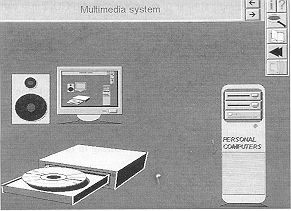 |
Fig. 4 - A
Multimedia Interactive System: Reference Standard. |
|
User-computer dialogue is defined as
INTERACTIVITY (a TV remote control is a simple kind of interactive instrument, as is also
the joystick in videogames, etc.).
INTERACTIVE MULTIMEDIA SYSTEMS combine communication instruments (texts, graphics, films,
etc.) with the interactive technologies of computers (keyboard, mouse, joystick, remote
control, touch-screen, etc.). The multimedia products that can be developed most
effectively are related to sectors involved in increasing or modifying communication in
the sense of greater clarity and incisiveness, especially when directed at nonspecialist
users. Computer rooms for the management of interactive multimedia courses and computer
"kiosks" or information booths are good examples of this kind of product.
Effectiveness
Multimedia communication between user
and computer is therefore based on greater interactivity and the possibility of presenting
the same kind of information through various media. Recent studies have shown that the
greater the number of media used to transmit a communication, the longer people can
remember it. Also, it is by the process of interaction - meaning the two-way transfer of
information - that communication becomes particularly effective. Some applications
essentially exploit the potential of hypertexts in the organization of information; others
simultaneously involve several users, distributing multimedia information between various
work stations; while the most advanced aim at achieving a highly realistic level in the
interaction between user and computer by generating sophisticated simulations of the
surrounding world (virtual reality). The key elements for the creation of an interactive
multimedia system are:
Technologies based on personal computers combining text, images, sounds and animation, to
form a single message that is rich in information and effective at the communication
level.
A highly facilitated interaction in order to shift the emphasis of the communicative
process to the user who thus participates directly in the action. A complete and
well-structured program which at the opportune moment makes it possible for the video
windows to fill with moving images, the icons to transform into cartoon images, and the
graphic and acoustic signals (words or music) to become standard forms of communication
between user and system by means of simple commands.
These systems also make it possible to assess the user's learning progress by providing
objective ele ments for self-testing and reviewing of the teaching pro grams.
Development of the project
Five laboratories in five Burns
Centres in Greece, France, Italy and Spain collaborated in the standardized collection of
textual and iconographic material Each Burn Centre is equipped with personal computers,
laser printer, modem for data transmission and application software for the development of
the project. To render the Centres operative, the COMETT project provided for training
courses to be held in turn in each of the four countries concerned. The object of the
courses at the Centres has been to give training in the use of interactive multimedia
programs and technology, in order to provide a common text and icon development program.
At each Centre, besides the analysis and drafting of the texts relative to the topics
assigned to it, a team of specialist physicians, Computer experts and multimedia
technicians supervised a procedure of selection, preliminary image digitalization and
processing, producing a first print-out of the material. The five laboratories were
coordinated by the Mediterranean Burns Club in Palermo, which acted as the centre for the
collection and further processing of images, revision and analysis of textual and
iconographic material, and assessment of the product received, preliminary to the
realization of the final product. The MBC laboratory acted as a central data bank,
constituting the archive for the assessment, updating and conflnuous enhancement of the
multimedia application in its preparatory phase, until the achievement of the intended
objectives and the actual production of the finished product.
As technological partner, INFORMED, an information technology company specializing in the
medical and scientific field, collaborated directly with the scientific partners in the
organization and definition of the standards neces sary for the implementation of all the
interactive multimedia applications.
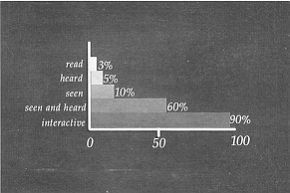 |
Fig. 5 - Effectiveness
of systems communication: comparison between Multimedia and others. |
|
INFORMED also had the task of designing and reali- 4.
Toulouse zing the hypertext navigation system and the user-interface, performing the final
processing of images and text, 5. Turin and producing the CD-ROM. The joint activity of
the Centres, the MBC laboratory and the INFORMED company made it possible to create a
complete training system that is scientifically valid and technically advanced. The
project has realized the following objectives:
- a multimedia system developed on CD-ROM that can be used
as:
- a training instrument in burns care departments for medical
and paramedical personnel
- a teaching aid in medical degree courses
- an educational tool for prevention, first aid, etc. for the
general public and voluntary organizations
- a network of laboratories for image
filing with a central coordination base at the MBC in Palermo the training of specialized
medical personnel in the treatment and therapy of burns using advanced technology systems
- the training of technicians capable
of managing technology for the processing and filing of iconographic and textual data
using multimedia systems exposing non-medical firefighting personnel to burns problems The
specific scientific contribution of each partner to the general issue of burns has been
distributed as follows:
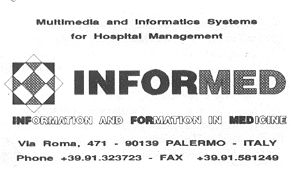 |
Fig. 6 - INFORMED,
the technological partner of COMETT Project |
|
- Athens Enteral nutrition Pain
- Madrid Sepsis Immunology Local therapy
- Palermo Prevention Physiopathology Reanimation therapy
Psychological and functional recovery Fire disasters Surgical therapy Parenteral nutrition
Characteristics of the "Burns Disease" CD-ROM
- The CD-ROM
on burns is an instrument that can be
consulted autonomously. The hypertext offers a rapid and effective analysis of the
problems arising in hospitals that admit burn patients. This organic consultation by
specialists and other physicians is performed by following training modules on issues
developed by the scientific partners. The modules can be compared with training courses.
CDROM is an efficient computerized training tool.
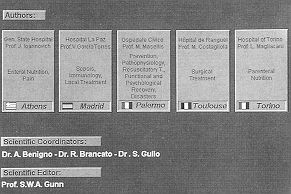 |
Fig. 7 - Specific
scientific contribution of each Partner |
|
- CD-ROM is a distance training tool for medical and
paramedical personnel. It can be used as a specialized teaching aid in degree courses in
the burns field. The product has been issued in two versions, English and Italian, and
other translations are envisaged.
- Consultation of CD-ROM requires a PC with an Intel
80386 microprocessor, MS-DOS 5.0 operating system or later versions and Windows 3.1, 4 Mb
Ram, hard disk, mouse, VGA card, colour monitor, CD-ROM reader and audio card with
loudspeakers. The audio card and loudspeakers are not essential but strongly recommended
for better communicative results, as all the texts can be heard and/or visualized.
Description of functioning
When a CD-ROM is installed in a CD-ROM reader -after
an initial phase of guided procedures necessary for the installation of the program on the
user's PC - access is obtained to the menu of the multimedia hypertext.
The user in sequence presses the buttons referring to the chosen topic, in progressively
greater detail, arriving finally at the pages selected. In order to navigate in the
program in general and in the context of the selected page in particular, the mouse is
used to select squares called "buttons" or "icons" to be found on-
every page of the program. These groups of "buttons" or "icons" on
every page help users to find a series of information about the program in interactive
fashion. In this way they can go deeper into the scientific teaching content of the
various topics included in the program.
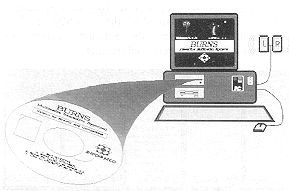 |
Fig. 8 - CD-ROM
"BURNS": consultation requirements |
|
For example: the book icon indicates
the possibility of viewing the written text relative to the chosen subject; the magnifying-glass
icon provides a more detailed in-depth study of the. subject processed by the same
logic - a green lens means that there are in-depth studies, a red lens means that there
are not; the forward arrow icon scrolls the following pages, allowing continuation
of the same subject in the same fashion as the previous page; the reverse arrow icon returns
the user to the previous page; the loudspeaker icon starts the spoken commentary
related to the pages and images where the icon appears; the index icon, like the
analytic index in a printed book, makes it possible to select the page regarding a chosen
subject; and the menu icon is for return to the general menu in order to set out
again from the starting point of the program.
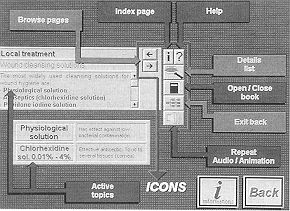 |
Fig. 9 - The
"Icons": The program navigation multimedia system |
|
One section of the program shows in detail
the meaning of all the icons; this section can be called up from any page by pressing the
question-mark icon. At every page selected an image appears which can then be integrated,
using the loudspeaker and book icons, by an animation and spoken commentary and by a
written text. At the end of the description the navigation icons can be used to interact
with the program for in-depth studies of the subjects treated.
All these steps are normal and usual procedures in computer-based training systems.
Conclusions
The results obtained by the project
can be summarized as follows:
- training of all partners in the potentials of image
processing systems
- training in systems and methodologies for developing
multimedia applications
- production of a multimedia application on CD-ROM for use as
a training instrument in Burns Centres for medical and paramedical personnel and as a
teaching aid in university medical degree courses with particular reference to burns.
These results correspond to the results
planned in the drafting phase of the project.
The project has thus achieved its dual target of training personnel in the use of
multimedia information technology instruments and of producing a publication on burns
based on experiences in the Mediterranean area in the form of an interactive multimedia
hypertext developed on CD-ROM.
Innovative technologies have been employed to integrate the expertise possessed by the
partners in the various Mediterranean countries in burn-related themes. The overall
information assembled in the project constitutes a single corpus of knowledge that can be
used for the training of large numbers of persons in university medical structures
(medical researchers and university students) specializing in the field of the prevention,
treatment and functional recovery of burns, in countries that are Members of the
Mediterranean Burns Club.
As a subsidiary benefit, the product will make it possible, on the one hand, to guarantee
the continuous training of specialized medical personnel working in burns centres in
various hospitals and, on the other, to educate the general public in terms of prevention
and service.
The various partners have been actively engaged in promoting the use of interactive
multimedia applications, especially as regards training in schools and university courses,
and the European Union has acknowledged its utility.
A traditional-type text on burns is being written in collaboration with the various
partners in the project. In printed form this will cover the same subjects as those
treated in the multimedia product.
It is expected that INFORMED will market the multimedia application not only as an
autonomous teaching aid for specialist training but also as an information technology
support for the companion book that we intend to publish. This is a joint forward-looking
effort in education.
RESUME. COMETT (Programme
Communautaire pour l'Education et la Formation Technologique) est un instrument proposé
par l'Union Européenne pour améliorer la coopération entre les universités, les
centres de recherches et le monde industriel et commercial. Un des buts que le projet
COMETT s'est fixé est d'utiliser cette coopération pour accélérer le processus de la
transmission de la technologique de la part des centres d'enseignement supérieur vers les
applications industrielles, en favorisant les cours de formations qui utilisent les
nouvelles technologies. Dans l'esprit du projet COMETT, le Club Méditerranéen des
Brûlures en 1990 a présenté un projet intitulé "Réseau européen pour la
constitution de documentation textuelle et iconographique relative aux brûlures dans la
région méditerranéenne", avec le but de produire un plan de formation commun à
tous les partenaires à travers l'emploi de technologies innovatrices et en particulier
les applications multimédiales. Les objectifs principaux sont d'améliorer et
d'uniformiser le niveau de spécialisation professionnelle, de promouvoir les activités
dans le champ de la prévention, la thérapie et la rééducation des brûlés, et
d'améliorer les soins et les opérations de secours dans les catastrophes d'incendies.
Cinq partenaires académiques et un partenaire technique ont collaboré dans le projet. Le
système est un instrument authentique pour J'enseignement que l'on peut utiliser pour la
formation dans le champ général des brûlures et pour les études. approfondies des
problèmes spécifiques. Les solutions technologiques sont décrites. Les résultats
obtenus sont en bref les suivants: formation de tous les partenaires académiques dans les
potentialités des systèmes d'élaboration de l'image; formation dans les systèmes et
les méthodologies pour le développement des applications multimédiales; production
d'une application sur CD-ROM pour utiliser comme instrument de formation dans les Centres
des Brûlés pour le personnel médical et paramédical et comme outil pédagogique dans
les cours universitaires qui s'occupent en manière particulière des brûlures.
MULTIMEDIA BIBLIOGRAPHY
- J. A. Waterworth, Multimedia. tecnologia e
applicazioni, Padova: Muzzio 1992.
- Massimo Giustiniani, Roberto Bonazzi, Comunicazione
e multimediatiO. Guida teorico-pratica alla realizzazione di sistemi multimediali
efficaci. Collana informatica domani, Franco Angeli, Milano 1992.
- Gaetano Kanizsa, Grammatica del vedere, 11 Mulino,
Bologna 1980.
- Barbara Minto, Dall'idea at testo, Isedi, Torino
1988.
- Josef Albers, Interazioni del colore, Pratiche
editrice, Parma 1991.
- Giorgio Fioravanti, 11 manuale del grafico,
Zanichelli, Bologna 1987.
- Massimo Giustiniani, Macchine parlanti, Franco
Angeli, Milano 1990.
- Pierluigi Ridolfi, Multimedialit~: Tecnologie e
applicazioni, Collana informatica domani, Franco Angeli, Milano 1992.
- Philip Shaddock, Multimedia in pratica, Mcgraw-Hill
libri italia srl, Milano 1993.
- Multimedia - Comunicazione, formazione e
tectrologie, Torino.
- Annuario italiario del multimedia 1993, Torino.
- Virtual - Mensile di realO virtuale e immagini di
sintesi, Milano.
- Multimedia personal computing, Milano.
Technological solutions adopted in the COMETT
project
The interactive multimedia
application, involving all the medical and scientific aspects of the project, had to be
produced on a support that would allow maximum diffusion among the intended target users,
i.e. medical and paramedical personnel in university and hospital structures.
In the first version of the project it was planned to issue the application on
CD-I, which has certain advantages. But considering the limited diffusion of CD-I readers,
it was decided to examine the alternative of issuing the application on CD-ROM. CD-ROM technology
is today decidedly more mature than CD-I technology, as a result of being on the market
for some ten years.
CD-ROM technology requires memorization of information on a support similar
to an ordinary audio CD, but it can be read by using a special reader connected to a PC.
For this reason, the CD-ROM target user is a person who already uses or has access
to a PC. With this technology it is now possible to integrate alphanumeric characters,
graphics, animated graphics, still images, moving images and audio, reaching and in some
cases exceeding CD-I potential. The interactivity of the user-PC relationship is provided
by the keyboard, mouse, touch-screen, etc.
Advantages: widespread diffusion of PCs in scientific circles; better
quality of video interface; implementation of the applications through development
environments on PC.
Disadvantages: use possible only on PC with CD reader.
In the light of comparison between the two technologies available, and considering
the poor diffusion of CD-I, it was decided - at parity of cost for the development of
interactive multimedia applications and also bearing in mind the target user to opt for
CD-ROM, for the following reasons:
- it is better suited for a medical and scientific
text
- CD-ROM readers are now available on any PC at
reasonably low cost
- more and more classrooms are now equipped with PCs
equipped with CD-ROM readers and multimedia peripherals
|








